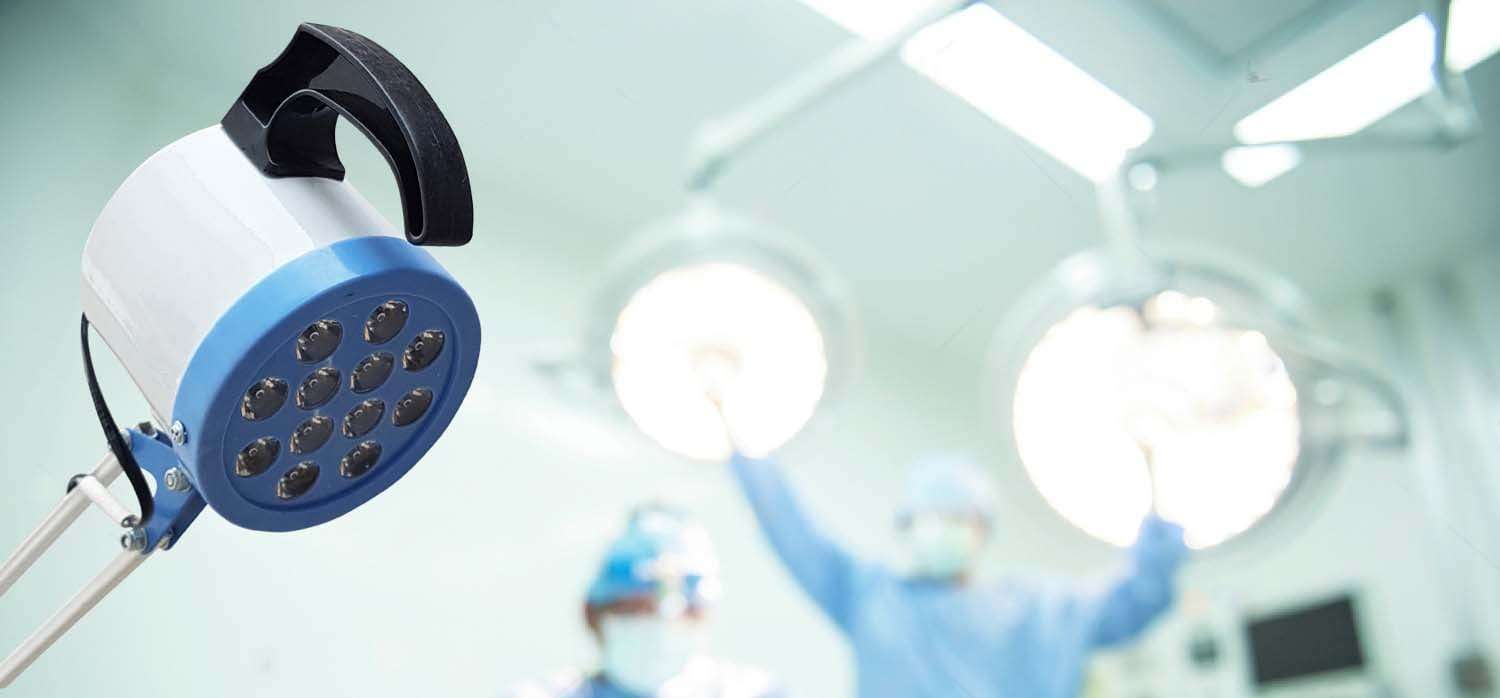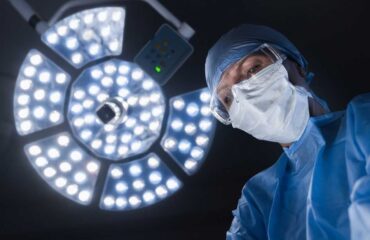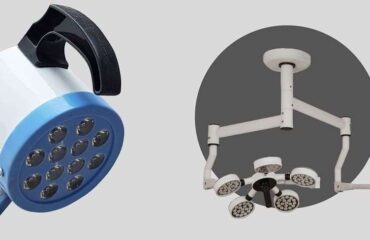O.T. (Operating Theater) lights and examination lights are essential medical equipment used in healthcare settings to provide optimal illumination during medical procedures and examinations.

Here is an overview of each:
O.T. (Operating Theater) Lights
Purpose:
- These lights are specifically designed for use in operating rooms to ensure surgeons have a clear and well-lit view of the surgical site. Proper lighting is critical for precision and safety during surgeries.
Features:
- High Intensity: OT. lights provide bright and consistent illumination without causing shadows or glare.
- Adjustability: They are highly adjustable, allowing for changes in intensity and focus. The lights can be positioned at various angles and heights to suit different surgical needs.
- Color Rendering Index (CRI): High CRI ensures that colors are rendered accurately, which is vital for identifying tissues and blood vessels.
- Heat Management: Advanced designs minimize heat output to ensure patient comfort and avoid tissue drying.
- Sterility: The design often includes features to maintain sterility, such as smooth surfaces that are easy to clean and sterilize.
Types:
- Ceiling-mounted: Fixed to the ceiling, these provide a wide range of movement and are common in most operating rooms.
- Wall-mounted: Used when ceiling mounts are not feasible, though less common.
- Mobile: Portable units that can be moved around as needed, providing flexibility in smaller or multi-purpose operating rooms.
Examination Lights
Purpose:
- Examination lights are used in general medical and dental examinations to provide adequate illumination for accurate diagnosis and minor procedures.
Features:
- Adjustability: These lights are also adjustable but typically to a lesser degree than O.T. lights. They can be positioned to provide focused light where needed.
- Light Quality: They offer bright, clear light, though usually with lower intensity compared to surgical lights.
- Versatility: Examination lights are versatile, used in a variety of settings including general practitioner offices, dental clinics, and outpatient departments.
- Energy Efficiency: Often designed to be energy efficient, many use LED technology for long-lasting performance and reduced energy consumption.
Types:
- Floor-standing: Mobile and adjustable, these lights can be moved around the examination room.
- Wall-mounted: Fixed to the wall, saving floor space and providing a stable light source.
- Ceiling-mounted: Less common but used in situations where floor or wall space is limited.
- Handheld: Portable and used for specific, close-up examinations.
Both O.T. and examination lights play crucial roles in ensuring that healthcare professionals can perform their duties effectively by providing the necessary visibility and clarity during medical procedures and examinations.
Role of surgical lights in health care industry
Surgical lights, also known as operating theater lights, play a critical role in the healthcare industry. Their primary function is to provide optimal illumination during surgical procedures, ensuring that surgeons and medical staff have a clear, unobstructed view of the surgical area. Here are several key roles and benefits of surgical lights in the healthcare industry:
Enhanced Visibility and Precision
- Illumination: Surgical lights offer high-intensity, shadow-free illumination, which is essential for intricate and detailed surgical work.
- Color Rendering: They have a high Color Rendering Index (CRI), which allows for accurate differentiation of tissues, blood vessels, and other anatomical structures.
Improved Patient Safety
- Accurate Diagnosis and Treatment: With better visibility, surgeons can perform more precise incisions and procedures, reducing the risk of errors.
- Minimized Tissue Damage: Advanced surgical lights produce less heat, reducing the risk of drying out or damaging tissues during long procedures.
Operational Efficiency
- Adjustability: Surgical lights are highly adjustable, allowing medical staff to reposition them as needed without interrupting the procedure.
- Reliability: Modern surgical lights are designed to be reliable and provide consistent performance, minimizing downtime and disruptions during surgeries.
Enhanced Working Conditions
- Ergonomics: Well-designed surgical lights reduce eye strain for surgeons and staff, improving their comfort and reducing fatigue during long procedures.
- Sterility: Features like smooth surfaces and easy-to-clean materials help maintain a sterile environment, crucial for infection control.
Technological Integration
- Advanced Features: Some surgical lights come with integrated cameras, monitors, and other advanced features that can be used for teaching, recording procedures, and enhancing surgical techniques.
- Compatibility: They can be integrated with other surgical equipment and systems, facilitating a seamless workflow in the operating room.
Cost-Effectiveness
- Energy Efficiency: Modern surgical lights, especially those using LED technology, are energy-efficient and have a long lifespan, which reduces operational costs.
- Maintenance: Durable and low-maintenance designs contribute to lower long-term costs and less frequent need for replacements or repairs.
Versatility
- Wide Range of Applications: Surgical lights are used not only in traditional operating rooms but also in outpatient surgery centers, dental surgeries, veterinary surgeries, and specialized procedure rooms.
- Adaptability: They can be used for a variety of procedures, from minor surgeries to major, complex operations.
Educational and Training Value
- Recording and Broadcasting: Integrated with video systems, surgical lights can be used to record and broadcast surgeries for educational purposes, allowing medical students and professionals to learn from real-life procedures.
- Simulation Training: High-quality lighting is essential in simulation training environments to mimic real surgical conditions.
Surgical lights are indispensable in the healthcare industry, contributing significantly to the success and safety of surgical procedures. Their role extends beyond illumination, encompassing aspects of efficiency, ergonomics, technological integration, and overall improvement in patient care. As technology advances, surgical lights continue to evolve, offering even more benefits and capabilities to meet the growing demands of modern medicine.
Tips before buying O.T. & Examination Lights in India
When purchasing O.T. (Operating Theater) and examination lights in India, it is essential to consider several factors to ensure you get the best equipment for your healthcare facility. Here are some tips to guide your purchase:
Tips for Buying O.T. Lights
Light Intensity and Brightness
- Ensure the lights provide adequate illumination (measured in lux) to cover various types of surgeries.
- Look for adjustable intensity controls to adapt to different surgical needs.
Color Rendering Index (CRI)
- High CRI is crucial for accurate color representation, helping distinguish between different tissues and structures.
Shadow Reduction
- Choose lights designed to minimize shadows, ensuring consistent illumination even when the surgical team is working.
Heat Management
- Opt for lights with advanced heat management systems to prevent overheating, which can cause discomfort and tissue drying.
Flexibility and Adjustability
- Check for multi-directional adjustability, allowing precise positioning and focus during surgeries.
Sterility and Cleanability
- Ensure the design allows for easy cleaning and sterilization to maintain a sterile environment in the operating room.
Energy Efficiency
- LED lights are generally more energy-efficient and have a longer lifespan compared to traditional halogen lights.
Backup and Reliability
- Ensure the lights have a reliable backup system in case of power failure, ensuring continuous illumination during surgeries.
Warranty and After-Sales Service
- Consider products that come with a good warranty and reliable after-sales support for maintenance and repairs.
Certification and Standards
- Check if the lights meet international and national safety and performance standards, such as CE, ISO, and BIS certifications.
Tips for Buying Examination Lights
Light Quality and Brightness
- Ensure the lights provide sufficient brightness for detailed examinations, typically around 10,000 to 100,000 lux.
Adjustability and Flexibility
- Look for lights that are easily adjustable in terms of height, angle, and focus to accommodate different examination needs.
Portability
- Depending on your needs, consider portable or mobile examination lights that can be easily moved around the clinic.
Energy Efficiency
- LED examination lights are more energy-efficient and have a longer lifespan, making them a cost-effective option.
Color Temperature
- Select lights with appropriate color temperature, usually around 4,000 to 5,000 Kelvin, which is comfortable for the eyes and provides natural light.
Durability
- Ensure the lights are built with durable materials to withstand frequent use in a busy healthcare setting.
Ease of Use
- Choose lights that are user-friendly, with intuitive controls for adjusting brightness and focus.
Maintenance
- Consider the ease of maintenance and the availability of replacement parts to ensure the lights remain functional for a long time.
Cost
- Balance the initial cost with long-term benefits, such as energy savings, durability, and reduced maintenance costs.
Reputable Brands and Suppliers
- Purchase from reputable brands and suppliers with positive reviews and a proven track record in the healthcare industry.
Additional Considerations
- Consult with Medical Staff: Gather input from surgeons and medical staff who will be using the lights to ensure the equipment meets their needs and preferences.
- Demo and Trial: If possible, arrange for a demonstration or trial period to evaluate the lights in real-world conditions before making a final decision.
- Budget: Consider your budget constraints but prioritize quality and features that are crucial for patient safety and staff efficiency.
- Compatibility: Ensure that the new lights are compatible with existing infrastructure and equipment in your facility.
By carefully considering these factors, you can make an informed decision when purchasing O.T. and examination lights, ensuring that you equip your healthcare facility with reliable, efficient, and high-quality lighting solutions.

